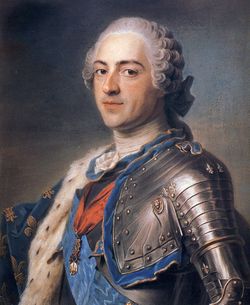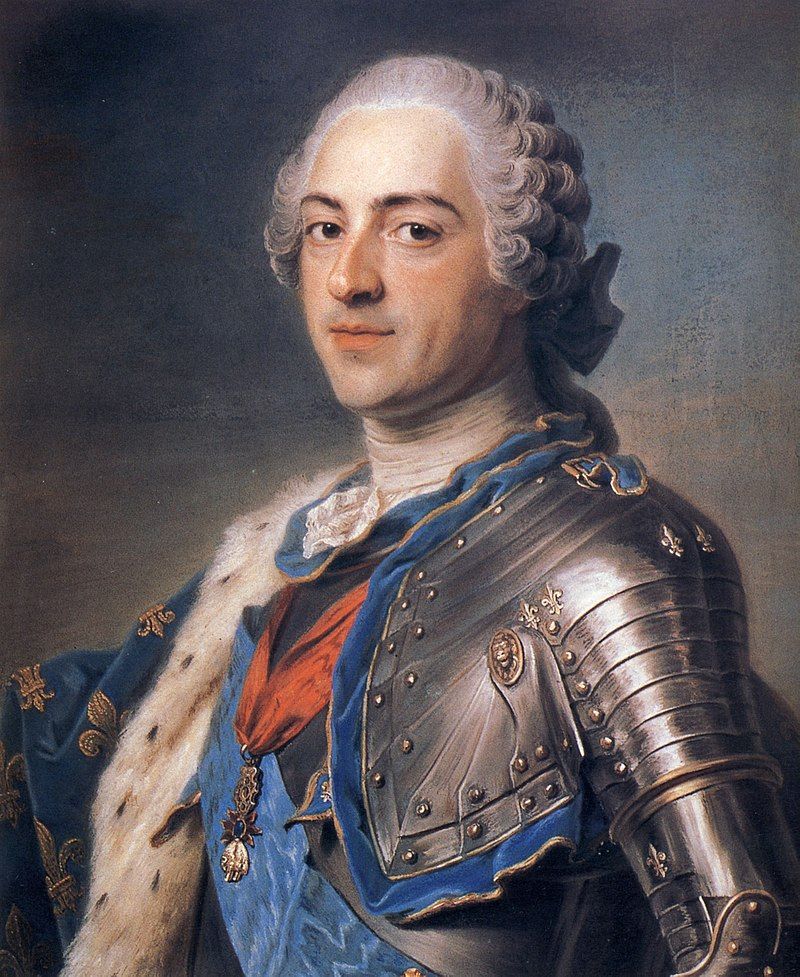Advertisement
King of France and Navarre. Louis XV, third son of Louis, Duke of Burgundy, and his wife Marie Adélaïde of Savoy, was born in the Palace of Versailles. He succeeded his great-grandfather King Louis XIV at the age of five. The intermediate heirs of his great-grandfather - his grandfather Louis, Le Grand Dauphin; his father Louis the duke; and his two elder brothers - had all predeceased his great-grandfather. Louis had been left an orphan in 1712, due to an outbreak of measles which claimed the lives of his parents and his remaining brother. His first cousin twice-removed, Philippe II, Duke of Orléans, served as Regent until he reached his majority in 1723 at the age of 13. In 1721, the 11-year-old was engaged to his first cousin, three-year-old Maria Anna Victoria of Spain. However, due to concerns about the health of the young king and the need to produce an heir, the engagement was broken and a princess sought who was old enough to have children. In September of 1725, 21-year-old Marie Leszczynska, daughter of the deposed King of Poland, married the 15-year-old king. The marriage produced many children, but the king's infidelities were legendary. He had numerous mistresses. Two of his most notorious mistresses included Madame de Pompadour and Madame du Barry. Jeanne Antoinette Poisson, the Marquise de Pompadour, was his official mistress from 1745 to 1764. Marie Jeanne Bécu, the Comtesse du Barry, was the official mistress from 1768 until Louis' death in 1774. Several of his mistresses exerted influence in his choice of minister of state. The most peaceful and prosperous portion of Louis' reign was during the ministry from 1726 to 1743, when the Cardinal de Fleury ruled France with the king's consent. After the death of Fleury in 1743, the king ruled without a first minister. The king entered the War of the Austrian Succession on the side of Prussia. France won that war and the king's popularity peaked. However, Louis shocked Europe in 1748 by agreeing to restore to Austria all the territory won in the war. While he was hailed elsewhere, his popularity in France sharply declined. In addition, France lost in the Seven Years War with Britain. In January of 1757, Louis survived an assassination attempt. The perpetrator suffered hours of torture and dismemberment and, still alive, burning at the stake. The king, who had forgiven the would-be assassin, apparently had no hand in the selection of the manner of execution. The Parlement of Paris had chosen the gruesome method, which had not been utilized in 147 years. Louis XV contracted smallpox and died at the Palace of Versailles in 1774. Since his son Louis the dauphin had predeceased him, the throne passed to his grandson, Louis XVI. The dissatisfaction with the monarchy under the reign of Louis XV contributed to a general unrest which culminated in the French Revolution. Though Louis XV is buried in the Basilica of Saint Denis, he does not have a tomb.
King of France and Navarre. Louis XV, third son of Louis, Duke of Burgundy, and his wife Marie Adélaïde of Savoy, was born in the Palace of Versailles. He succeeded his great-grandfather King Louis XIV at the age of five. The intermediate heirs of his great-grandfather - his grandfather Louis, Le Grand Dauphin; his father Louis the duke; and his two elder brothers - had all predeceased his great-grandfather. Louis had been left an orphan in 1712, due to an outbreak of measles which claimed the lives of his parents and his remaining brother. His first cousin twice-removed, Philippe II, Duke of Orléans, served as Regent until he reached his majority in 1723 at the age of 13. In 1721, the 11-year-old was engaged to his first cousin, three-year-old Maria Anna Victoria of Spain. However, due to concerns about the health of the young king and the need to produce an heir, the engagement was broken and a princess sought who was old enough to have children. In September of 1725, 21-year-old Marie Leszczynska, daughter of the deposed King of Poland, married the 15-year-old king. The marriage produced many children, but the king's infidelities were legendary. He had numerous mistresses. Two of his most notorious mistresses included Madame de Pompadour and Madame du Barry. Jeanne Antoinette Poisson, the Marquise de Pompadour, was his official mistress from 1745 to 1764. Marie Jeanne Bécu, the Comtesse du Barry, was the official mistress from 1768 until Louis' death in 1774. Several of his mistresses exerted influence in his choice of minister of state. The most peaceful and prosperous portion of Louis' reign was during the ministry from 1726 to 1743, when the Cardinal de Fleury ruled France with the king's consent. After the death of Fleury in 1743, the king ruled without a first minister. The king entered the War of the Austrian Succession on the side of Prussia. France won that war and the king's popularity peaked. However, Louis shocked Europe in 1748 by agreeing to restore to Austria all the territory won in the war. While he was hailed elsewhere, his popularity in France sharply declined. In addition, France lost in the Seven Years War with Britain. In January of 1757, Louis survived an assassination attempt. The perpetrator suffered hours of torture and dismemberment and, still alive, burning at the stake. The king, who had forgiven the would-be assassin, apparently had no hand in the selection of the manner of execution. The Parlement of Paris had chosen the gruesome method, which had not been utilized in 147 years. Louis XV contracted smallpox and died at the Palace of Versailles in 1774. Since his son Louis the dauphin had predeceased him, the throne passed to his grandson, Louis XVI. The dissatisfaction with the monarchy under the reign of Louis XV contributed to a general unrest which culminated in the French Revolution. Though Louis XV is buried in the Basilica of Saint Denis, he does not have a tomb.
Bio by: Anne Philbrick
Family Members
-
![]()
Henriette of France
1727–1752
-
![]()
Louise Élisabeth de France
1727–1759
-
![]()
Marie-Louise de France
1728–1733
-
![]()
Louis Ferdinand de Bourbon
1729–1765
-
![]()
Prince Louis-Ferdinand Bourbon
1729–1765
-
![]()
Philippe de France
1730–1733
-
![]()
Marie Adélaïde of France
1732–1800
-
![]()
Victoire of France
1733–1799
-
![]()
Sophie of France
1734–1782
-
![]()
Thérèse de France
1736–1744
-
![]()
Louise Marie of France
1737–1787
Advertisement
See more Louis XV memorials in:
Advertisement



















